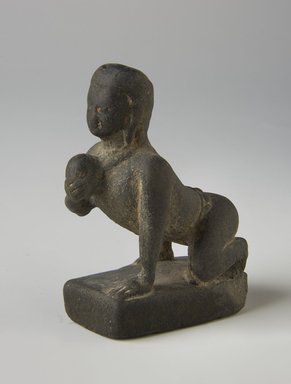
Medium: Stone
Geograhical Locations:
Dates:6th–7th century
Dimensions: 3 5/16 × 1 3/8 × 2 5/8 in. (8.4 × 3.5 × 6.7 cm)
Collections:
Museum Location: Asian Galleries, Arts of the Himalayas, 2nd floor
Exhibitions:
Accession Number: 77.203
Image: 77.203_PS11.jpg,
Catalogue Description: Krishna, hero of the Bhagavata Purana epic and deity worshipped by Vaishnava Hinduism, is shown here in his infancy as Gopala, the impish "Butter Thief," holding the butter ball he stole from his stepmother. Crouching on a rectangular base, he is represented as a child crawling on his left knee. He supports his weight on his left arm while he holds the butter ball to his chest with his right hand. He is naked except for a simple girdle around his waist and a beaded necklace; the figure may have originally worn actual gold bands at his wrists and ankles. His elegant cascading curls fall in a wig-like hairdo of small round curls. This figure is related stylistically to 6th-7th century Nepalese stone sculptures that reflect classic conventions of Gupta period (320-c. 550 A.D.) sculpture in India, such as the square face, swelling chest, coiffure of small snail-shell curls, simple ornaments, unadorned base, and a triumphant posture of bold, heroic portrayals. This Gopala image is important as it relates tylistically to the early Kaliya and other figures and as evidence of a cult of Krishna existing in Nepal as early as the 7th century, because although it is known that Krishna was worshipped from the 5th century in India, he is represented profusely in Nepalese sculpture and painting from the 15th century onwards. Condition: Worn. Corner of base at left foot of figure is now missing (old break). Traces of red puja on chin and yellow polychrome in crevices around eyes, hairline, and fingers.